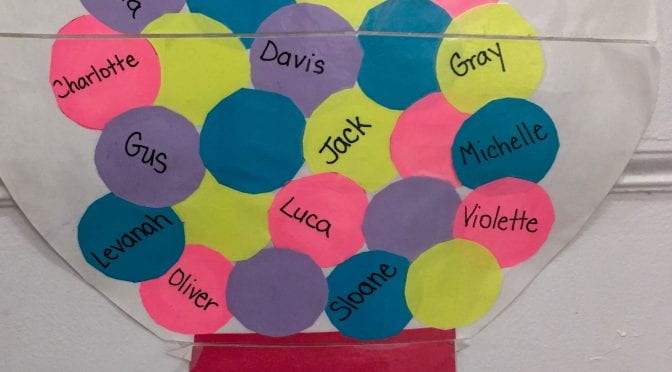Essential questions:
- How does morning meeting develop identity on a daily basis? How can this practice be deepened?
- How can morning meeting develop capacity for anti-bias work?
Guiding Questions:
- Where do our names come from?
- Why are they so important?
Many teachers in our school, including myself, utilize elements of the Responsive Classroom Approach to create more inclusive, equitable, and joyful class communities. The Teaching Tolerance Social Justice Anchor Standards provide a different framework through which to evaluate our effectiveness in creating these same communities. I decided to look specifically at one of the most commonly used tools: the morning meeting. When seeking out the ways in which the two frameworks supported with each other, and the early childhood experience, I found the most overlap in the Identity and Diversity domains. I decided to focus on the Greeting section of the morning meeting, when students and teachers greet one another by name.
Knowing that our names often have valuable stories to tell, I wanted to explore those depths. Rather than “We take care of each other, and so we say each other’s names correctly,” I hoped to move towards a collective understanding of “We honor the histories and connections that we all carry as we move through the world.” The framing of the question helped me address more directly standard #2 in Identity; Students will develop language and historical and cultural knowledge that affirm and accurately describe their membership in multiple identity groups; and standard #7 in Diversity; Students will develop language and knowledge to accurately and respectfully describe how people (including themselves) are both similar to and different from each other and others in their identity groups.
As an early childhood music educator I grappled with how to address this complex connection between names and history with young children. We have greeted each other in music every day since the beginning of the school year, yet I had never considered how varied our experiences with names might be. Some students had no idea where names come from, while others were able to talk about how their name connected them to their ancestors. During our conversations and through the reading of the book Alma and How She Got Her Name, I saw how engaged students were with the idea that we all have a name and all of our names have a story to tell.
“A name is a special word that tells other people who we are,” (Four year old – Black female). Though I have engaged with greetings over many years, this is my first experience where students are sharing so much of the connection between their name and their identity. As an organic extension of our conversation, by uplifting the value of these stories, we are also meeting Identity Standard 4, “Students will express pride, confidence, and healthy self-esteem without denying the value and dignity of other people.” Just today, a student shared “My name connects me with two strong women: my mom’s mom and Michelle Obama!”
I am eager to continue exploring this idea, in our greetings and through using our names as material for music making. I am also excited to keep looking at Responsive Classroom through an anti-bias lens. I believe that Responsive Classroom, with its community-based approach to social emotional learning, can help support a rich culture of anti-bias learning. I am continuing to think about other ideas about how to make the pairing more explicit.


Sara, I think there is something quite powerful in applying this lens to how we invite learners into our spaces and how this might be connected to something more than creating norms for how we interact as a community. By making each student’s identify present and valued as part of our opening routines we are being explicit about our intention to invite in the whole student. Allowing students to fully enter the learning space from the start messages a true invitation to learning, but also establishes structures for support and respect when when we encounter challenges that are connected to our different identifies. It will be interesting to see how these creates new opportunities related to making music.